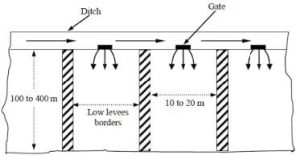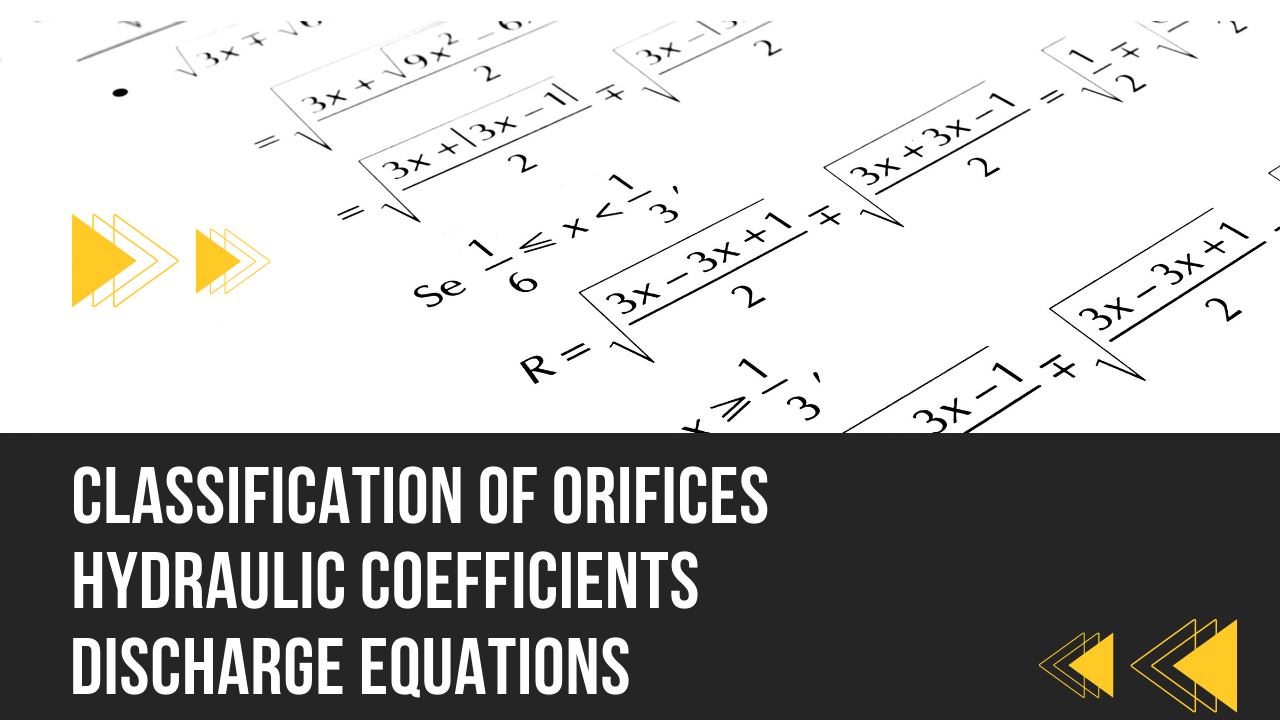Table of Contents
Different Methods of Irrigation
The basic requirement for adoption of any method are
- Uniform distribution of 6-20 cm depth of water depending on the nature of crops,
- Economical conveyance structure,
- Large discharge of water causing for reduction of conveyance losses, and labour cost, and
- Mechanised farming is possible
Surface Irrigation
- Water is applied to the soil surface and the water flows by gravity either through furrows, strips or basins.
- Water is applied from a channel located at the upper reach of the
- Loss of water by conveyance and deep percolation is high and the efficiency of irrigation is only 40-50% at field level in this method of irrigation.
- Controlled: Water is applied from the head ditch and guided by corrugations, furrows, borders, or ridges.
- Uncontrolled: Wild
Common Types of Surface Irrigation
- Furrow irrigation
- Border irrigation
- Basin irrigation
1) Furrow Irrigation

- In this method water is applied on the field is directed to flow through narrow channels dug between the rows of crops, instead of distributing the water throughout the whole field evenly.
- The furrows must all have equal dimensions, in order to guarantee that the water is distributed evenly.
- Furrow irrigation is a cheap method in areas where water is inexpensive.
- Suitable for mild slope and problematic in steep slope terrain’s due to erosion problem.
- Shape of furrows mainly depends on the type of soil and the size of the stream
- Deep, narrow V-shaped furrow – suitable for sandy soil
- Wide, shallow furrow suitable for clay soil
- Shape and Spacing of Furrows: Heights of ridges vary between 15 cm and 40 cm
- The range of spacing commonly used is from 3 to 1.8 m with 1.0 m as the average.
- Maximum slope for different soil types
Soil Type Maximum slopes*
Sand 0.25
Sandy loam 0.40
Fine sandy loam 0.50
Clay 2.50
Loam 6.25
2) Border Irrigation
- In this method, parallel ridges are made to guide a sheet of flowing water when the water moves down the
- The field is divided into several long parallel strips called borders that are separated by low ridges.
- Field should be even surface over which the water can flow down the slope with a nearly uniform
- Every strip is independently irrigated by turning a stream of water at the upper end.
- Water moves towards the lower end without erosion covering the entire width of the
- Then water spreads and flows down the strip in a thin sheet.
- Border method is suitable for most of the soils, while it is best suited for soil having moderately low to high infiltration rates.

3) Basin Irrigation

- This method of irrigation is adopted mainly in orchards.
- Usually round basins are made for small trees and square basin for large trees.
- These basins allow more water to be impounded as the root zones of orchard plants are usually very
- Each basin is flooded and water is allowed to infiltrate into the
- Based on type of crop and soil, nearly 5-10 cm depth of water may be needed for every irrigation.
- The advantage of basin method is that unskilled labour can be used as there is no risk of erosion.
- Disadvantages: there is difficulty in using modern machinery and it is also labour
Common Types of Surface Irrigation
Free Flooding or Ordinary Flooding
- In this type of irrigation, ditches are excavated in field, either on contour (known as contour flooding) or up and down known as free flooding.
- Water application on field with out levees is known as wild flooding and if levees are available then it is called controlled
Checks Flooding
- It similar to flooding method except flow is controlled by levees.
- Levees can be constructed along the contours or along the slope of a
- This method is suitable for permeable as well as less permeable soil.
Contour farming
Zig-zag Irrigation Method
Sprinkler Irrigation

- In this type of irrigation water is applied plants like natural
- Water is distributed through a system of pipes usually by
- Water under pressure is carried and sprayed into the air above the crop through a system of:
- Overhead perforated pipes, nozzle lines, or through nozzles fitted to riser pipes attached to a system of pipes laid on the
- Nozzles of fixed type or rotating under the pressure of water are set at suitable intervals in the distribution pipes.
- Sprayed water wets both the crop and the soil and, hence, has a refreshing effect.
- Water is applied at a rate less than the intake rate of soil so that there is no runoff.
- Measured quantity of water is applied to meet the soil water
- Suitability
- Sprinkler irrigation is suited for most row, field and tree crops and water can be sprayed over or under the crop
- Large sprinklers are not recommended for irrigation of delicate crops such as lettuce because the large water drops may damage the
Suitable slopes
- Sprinkler irrigation is adaptable to any farmable slope, whether uniform or
- Lateral pipes supplying water to the sprinklers should always be laid out along land
- This will minimize the pressure changes at the sprinklers and provide a uniform irrigation.
Suitability
- Uniform application by “artificial rain”
- Good application efficiencies (0.7 – 8)
- Dependent on wind, temperature, humidity
- Fairly terrain independent (but design must take terrain into account)
- Can have a low labor content
However,
- More initial cost
- High maintenance cost due to pumping
- Can be complex to run
Drip or Trickle Irrigation
In this irrigation system:
- Water is applied directly to the crop entire field is not wetted.
- Water is conserved
- Weeds are controlled because only the places getting water can grow
- There is a low pressure
- There is a slow rate of water application somewhat matching the consumptive use. Application rate can be as low as 1 – 12 l/hr.
- There is reduced evaporation, only potential transpiration is There is no need for a drainage system.
In this irrigation system:
- Water is applied close to plants so that only part of the soil in which the roots grow is wetted i.e. entire field is not
- Water is conserved
- Weeds are controlled because only the places getting water can grow
- There is a low pressure system.
- There is a slow rate of water application somewhat matching the consumptive use.
- Application rate can be as low as 1 – 12 l/hr.
- There is reduced evaporation, only potential transpiration is
- There is no need for a drainage system.
Suitability
- Drip irrigation is adaptable to any farmable
- Normally the crop would be planted along contour lines and the water supply pipes (laterals) would be laid along the contour also.
- This is done to minimize changes in emitter discharge as a result of land elevation
- Drip irrigation is suitable for most
- On clay soils water must be applied slowly to avoid surface water ponding and
- On sandy soils higher emitter discharge rates will be needed to ensure adequate lateral wetting of the soil.
- One of the main problems with drip irrigation is blockage of the
- All emitters have very small waterways ranging from 2-2.0 mm in diameter and these can become blocked if the water is not clean.
- Thus it is essential for irrigation water to be free of
- ]If this is not so then filtration of the irrigation water will be
- Blockage may also occur if the water contains algae, fertilizer deposits and dissolved chemicals which precipitate such as Ca and Fe.
- Filtration may remove some of the materials but the problem may be complex to solve and requires an experienced.

















